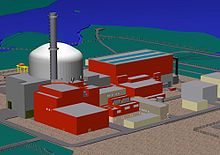
Computer generated image of one EPR nuclear power unit.
by Asia Maqsood 17 September 2018
French President Emmanuel Macron’s visit to India on March 9, 2018, has brought an unprecedented achievement for the latter. Macron and Modi announced to start work by the end of 2018 on the world’s largest nuclear power plant at the site in Jaitapur in India.
They issued a joint statement, “Once installed, the Jaitapur project will be the largest nuclear power plant in the world, with a total capacity of 9.6 Gigawatts”, on Saturday. “From the ground to the sky, there is no subject that India and France are not working together,” stated Modi.
The leaders of France and India reiterated their intention to start work by the end of this year on what could become the world’s largest nuclear power plant, advancing talks that have continued for nearly a decade. An initial agreement was signed between India’s Nuclear Power Corp and Areva which is a French multinational group specializing in nuclear power and renewable energy headquartered in Paris La Défense to work for civil nuclear cooperation on the Jaitapur project in 2009. India’s enhanced military power could have certain strategic implications for the region.
Pakistan must strengthen and enhance its maritime governance, strategies to contain Indo-US maritime activities. China-Pakistan should strengthen their strategic partnership in the maritime sector to strengthen its naval force.
Later on, French utility EDF has signed a preliminary agreement with Nuclear Power Corp of India Ltd (NPCIL) to build six nuclear reactors at Jaitapur, in the western coast of India in 2016 to secure certification for the European Pressurized Reactor (EPR) reactor in India.
“Once installed, the Jaitapur project will be the largest nuclear power plant in the world, with a total capacity of 9.6 gigawatts,” according to a joint statement issued Saturday by the governments during Macron’s visit to India. Both countries have also secured commercial contracts worth €13 billion during the visit.
When Macron was elected in May 2017, Modi visited France, the new era of Indo-French cooperation started. They have discussed many areas of cooperation including defense, maritime, space, security, and energy, terrorism, climate change, sustainable growth and development, infrastructure, urbanization, and science and technology.
These exchanges of visits are strengthening their bilateral relations. During this visit, Modi said, “Defense ties with India had reached a new high after the two nations signed a key security accord for the Indian Ocean to counter China’s growing influence in the region.”
India’s global aspirations to develop blue-water navy capabilities promise its strategic partnership with other world powers including the US. All these developments were started with the Indo-US nuclear deal on July 18, 2005.
The defence agreement between France and India during this Macron’s visit, India would be allowed to access to French military bases in the Indian Ocean enhancing their maritime cooperation.
The US has played a more significant role in bringing India in nuclear mainstreaming through this civil nuclear cooperation. Subsequently, India has signed civilian nuclear deals with several countries such as Australia, Japan, and France as well. As India is playing an active role in the Indo-Pacific region, India is seeking/taking major powers’ cooperation in the Indian Ocean. It claims that it is countering China’s regional ambitions in the Indian Ocean.
The latest development is that India is showing its enthusiasm in the “quad” of the US, Japan, Australia to contain China’s Belt and Road Initiative.
Simultaneously, India-France collaboration in the western part of Indian Ocean is enhancing. India has strong strategic cooperation with the US in the Indian Ocean with the signing of Logistics Exchange Memorandum of Agreement in 2016 which is aimed to facilitates the provision of logistical support, supplies, and services between the US and Indian militaries on the Indian Ocean and provides a framework to govern them. Eventually, India and the US became logistical allies.
Likewise, India’s membership in the MTCR (Missile Technology Control Regime) in the last year has reaffirmed the US support for India’s membership in the Nuclear Suppliers Group (NSG). As the membership in the NSG is based on consensus, all group states must agree to grant its membership to India. Otherwise, it is quite impossible.
India’s global aspirations to develop blue-water navy capabilities promise its strategic partnership with other world powers including the US. All these developments were started with the Indo-US nuclear deal on July 18, 2005.
There is dire need of a criteria-based approach to give its membership to non-NPT states. If India (non-NPT state) gets this membership, it would be a great blow to the non-proliferation regimes. Simultaneously, it will be enhancing India’s nuclear stockpile which will create strategic instability in South Asia. Moreover, if India would be a member of NSG, it will hamper Pakistan’s membership in this group in coming years. It reflects that India is expanding its global influence.
It seems that India’s intentions for building naval facilities in different island countries such as Seychelles, Mauritius, and Oman will be supported by the French military bases in Djibouti, Abu Dhabi, and Reunion Island. The defence agreement between France and India during this Macron’s visit, India would be allowed to access to French military bases in the Indian Ocean enhancing their maritime cooperation.
So, Pakistan must strengthen and enhance its maritime governance, strategies. China-Pakistan should enhance their strategic partnership on maritime to firm its navy. India’s enhanced military power could have certain strategic implications for the region.
